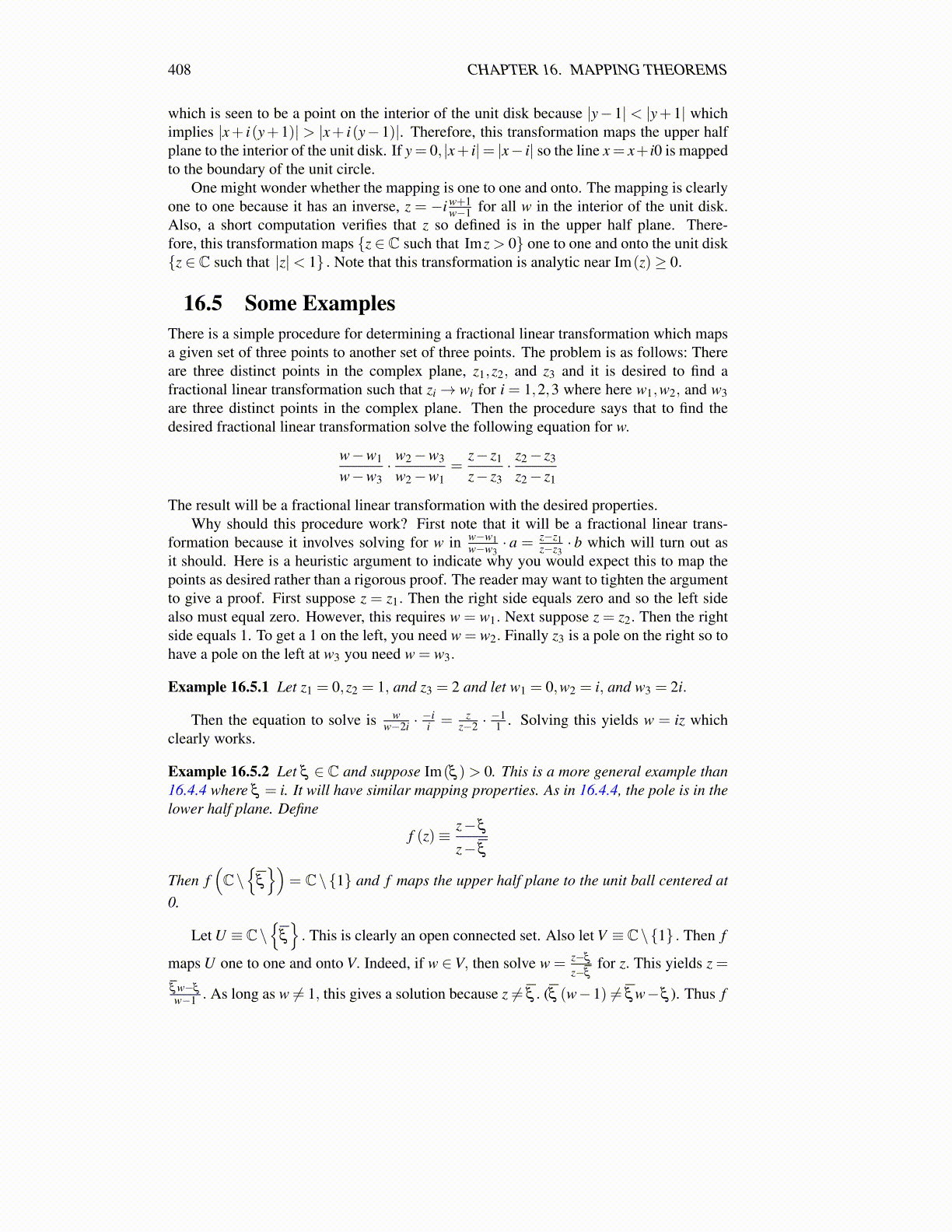
408 CHAPTER 16. MAPPING THEOREMS
which is seen to be a point on the interior of the unit disk because |y−1| < |y+1| whichimplies |x+ i(y+1)| > |x+ i(y−1)|. Therefore, this transformation maps the upper halfplane to the interior of the unit disk. If y = 0, |x+ i|= |x− i| so the line x = x+ i0 is mappedto the boundary of the unit circle.
One might wonder whether the mapping is one to one and onto. The mapping is clearlyone to one because it has an inverse, z = −i w+1
w−1 for all w in the interior of the unit disk.Also, a short computation verifies that z so defined is in the upper half plane. There-fore, this transformation maps {z ∈ C such that Imz > 0} one to one and onto the unit disk{z ∈ C such that |z|< 1} . Note that this transformation is analytic near Im(z)≥ 0.
16.5 Some ExamplesThere is a simple procedure for determining a fractional linear transformation which mapsa given set of three points to another set of three points. The problem is as follows: Thereare three distinct points in the complex plane, z1,z2, and z3 and it is desired to find afractional linear transformation such that zi→ wi for i = 1,2,3 where here w1,w2, and w3are three distinct points in the complex plane. Then the procedure says that to find thedesired fractional linear transformation solve the following equation for w.
w−w1
w−w3· w2−w3
w2−w1=
z− z1
z− z3· z2− z3
z2− z1
The result will be a fractional linear transformation with the desired properties.Why should this procedure work? First note that it will be a fractional linear trans-
formation because it involves solving for w in w−w1w−w3
· a = z−z1z−z3· b which will turn out as
it should. Here is a heuristic argument to indicate why you would expect this to map thepoints as desired rather than a rigorous proof. The reader may want to tighten the argumentto give a proof. First suppose z = z1. Then the right side equals zero and so the left sidealso must equal zero. However, this requires w = w1. Next suppose z = z2. Then the rightside equals 1. To get a 1 on the left, you need w = w2. Finally z3 is a pole on the right so tohave a pole on the left at w3 you need w = w3.
Example 16.5.1 Let z1 = 0,z2 = 1, and z3 = 2 and let w1 = 0,w2 = i, and w3 = 2i.
Then the equation to solve is ww−2i ·
−ii = z
z−2 ·−11 . Solving this yields w = iz which
clearly works.
Example 16.5.2 Let ξ ∈ C and suppose Im(ξ )> 0. This is a more general example than16.4.4 where ξ = i. It will have similar mapping properties. As in 16.4.4, the pole is in thelower half plane. Define
f (z)≡ z−ξ
z−ξ
Then f(C\{
ξ
})= C\{1} and f maps the upper half plane to the unit ball centered at
0.
Let U ≡C\{
ξ
}. This is clearly an open connected set. Also let V ≡C\{1} . Then f
maps U one to one and onto V. Indeed, if w ∈V, then solve w = z−ξ
z−ξfor z. This yields z =
ξ w−ξ
w−1 . As long as w ̸= 1, this gives a solution because z ̸= ξ . (ξ (w−1) ̸= ξ w−ξ ). Thus f